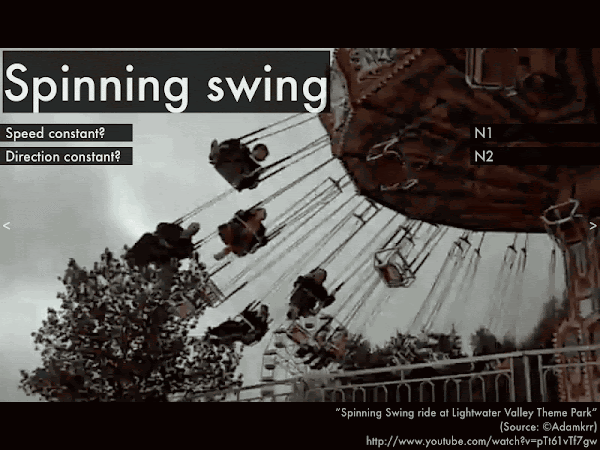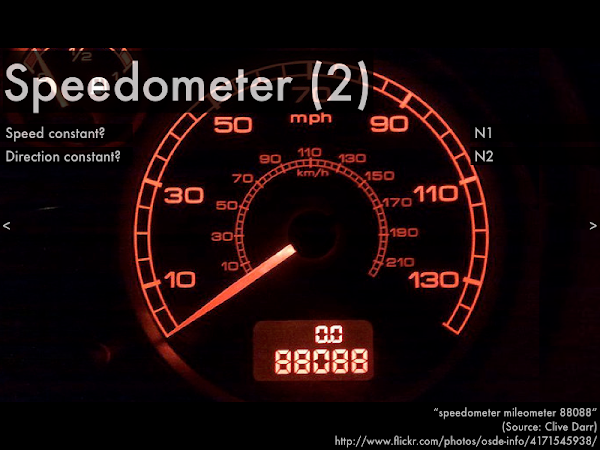Cuesta College, San Luis Obispo, CA
Students have a weekly online reading assignment (hosted by SurveyMonkey.com), where they answer questions based on reading their textbook, material covered in previous lectures, opinion questions, and/or asking (anonymous) questions or making (anonymous) comments. Full credit is given for completing the online reading assignment before next week's lecture, regardless if whether their answers are correct/incorrect. Selected results/questions/comments are addressed by the instructor at the start of the following lecture.
The following questions were asked on reading textbook chapters and previewing a presentation on forces and motion.
Selected/edited responses are given below.
Describe what you understand from the assigned textbook reading or presentation preview. Your description (2-3 sentences) should specifically demonstrate your level of understanding.
"I understand that Newton's first law applies when the net force acting on an object is zero, and the object has a constant speed and a constant direction. I also understand that Newton's second law of motion states that an object's acceleration is proportional to the net force acting on it and inversely proportional to its mass."
"Newton has three laws, but only two of them classify motion. The first law applies to an object that has a constant speed and constant direction or when a net force that equals zero. The second law applies to an object that does not have constant speed or constant direction or when a net force does not equal zero."
"Newton's first law works with objects traveling at a constant speed, in a constant direction. Or it does not move at all. Then the second law states that an object will not move unless it has some force to make it move."
"The difference between Newton's first and second law. I also know when to use which law."
"Newton's first law, how no force is required to keep an object in motion if there are no forces opposing its motion."
"The motion flowchart, in that if an object's speed and direction are constant we can apply Newton's first law. If either of the two aren't constant, we use Newton's second law."
"A change in movement for an object only happens if a force is applied. This includes gravity or air resistance. Inertia refers to an object's tendency to resist movement. The amount of mass and the inertia of it are closely related. The smaller the mass the less inertia it will have."
Describe what you found confusing from the assigned textbook reading or presentation preview. Your description (2-3 sentences) should specifically identify the concept(s) that you do not understand.
"I found Newton's laws to be a bit confusing and how to apply them to situations. Like the zero and non-zero net forces."
"The relationship that constant speed and constant direction have with the first and second law. Having trouble getting the differences between the laws."
Identify whether a zero or non-zero net force corresponds to Newton's first law or Newton's second law. (Only correct responses shown.)
Zero net force (ΣF = 0): Newton's first law ("N1") [88%]
Non-zero net force (ΣF ≠ 0): Newton's second law ("N2") [86%]

For the rocket sled, Newton's __________ law applies to the motion of this object, and the forces acting on the object add up to a __________ net force.
first; zero. ************* [13] second; non-zero. ****************************************** [42] (Unsure/guessing/lost/help!) ** [2]

While the F-35B is descending (before it touches the ground), Newton's __________ law applies to the motion of this object, and the forces acting on the object add up to a __________ net force.
first; zero. ****************************** [30] second; non-zero. ***************** [17] (Unsure/guessing/lost/help!) ********** [10]

For this car with a steady speedometer reading (and assuming the shaking is due to the person holding camera, and not from moving the car itself), Newton's __________ law applies to the motion of this object, and the forces acting on the object add up to a __________ net force.
first; zero. ****************************************** [42] second; non-zero. ********** [10] (Unsure/guessing/lost/help!) ***** [5]

For a person in the swinging chair ride moving along a circular trajectory at a constant speed, Newton's __________ law applies to the motion of this object, and the forces acting on the object add up to a __________ net force.
first; zero. ************************** [26] second; non-zero. *************************** [27] (Unsure/guessing/lost/help!) **** [4]

For this car with a zero speedometer reading, Newton's __________ law applies to the motion of this object, and the forces acting on the object add up to a __________ net force.
first; zero. ****************************************** [42] second; non-zero. ********** [10] (Unsure/guessing/lost/help!) ***** [5]
Ask the instructor an anonymous question, or make a comment. Selected questions/comments may be discussed in class.
"These motion examples are confusing because I don't fully understand how to apply Newton's Laws to them. We should quickly discuss these examples in the next class if there is time." (Yes. We totally should.)
"What questions can one ask oneself to determine whether it is Newton's first law or second law? (What questions? These questions. And these other questions.)
"Are the first two laws different in that one has no acceleration and the other doesn't, or is there more to it?" (Awesome--that's exactly how Newton's first two laws work.)
No comments:
Post a Comment